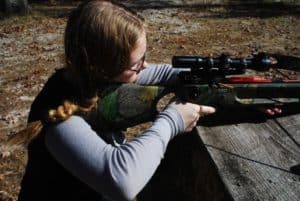by Bill Cooper
U.S. sportsmen, old, young, men, women and children, from 49 states, are reconnecting to the ancient past through the growing usage of crossbows for target and hunting pleasures. And the modern crossbow wars are finally over.
A bit of history
Crossbows have been utilized both for warfare and hunting as far back as 4,000 years ago. Scholars contend that crossbows first appeared in Asia around 2,000 BC and were carried into the battle at Ma-Ling in 341 B.C. As late as the Vietnam Conflict, Montanargd soldiers and U.S. Special Forces teams used crossbows for close combat.
The short-range weapon was first used to take game and has remained on the scene ever since.
Modern controversy fizzles
Modern crossbows have been a point of contention in the bowhunting world for five decades. Die-hard traditionalists and compound bow users have waged a hot-tempered equipment war against crossbow usage for hunting since Arkansas and Ohio legalized them in the early 1970s.

Thirty years of research has proven crossbow users harvest deer at the same rate as compound users, about a 15 percent success rate.
Those opposed to crossbows claimed that deer seasons would be shortened because of increased harvests and many more hunters in the woods during deer season. Others touted the weapons as more like guns and the weapons of poachers. Hard-line divisions between compound and crossbow users grew as offensive slurs towards crossbow users grew and competition for the attention of game department officials intensified.
Crossbows quickly gained popularity with compound users who had developed shoulder and wrist problems. The average compound user drops out of the sport at 49 years of age. The crossbow allows hunters to remain in the archery sport much longer. Next, women and children began jumping on the crossbow bandwagon.
The opponents camp gained ground in the 1970s and 80s because of their intense efforts and the lack of statistics about success rates with crossbows. Some opponents’ tactics approached political debauchery through invention of their own ill-conceived facts. Many comparisons compared crossbows to high-powered rifles, while the simple physics of a crossbow supported the theory that they performed much like a compound bow.
Facts and statistics were lacking, and the battles raged on. However, one by one, the states began to issue legislation that allowed crossbow usage on limited terms. As the years past, more states added crossbows bows to their lists of legal weapons for deer.
Facts finally float to top
Arkansas and Ohio lead the way with developing statistics about crossbow hunting. After 40 years of legalized crossbow usage, both states report that deer herds have not been decimated and seasons have not needed to be shortened. Likewise, accidents have not increased; nor has poaching. Many states have joined the two leaders, and none have reported any negative effects of hunting with a crossbow. And the bowhunting tradition continues at a stronger pace, even if hunters are using a short-range weapon that has been employed by the human race for over 4,000 years.
Positive influences of the crossbow
The facts are in. Crossbows have produced very positive results for the preservation of hunting traditions. They have proven to be fabulous recruitment tools. They have brought scores of new people into the archery sports of shooting and hunting. Smaller framed people, such as women and kids, have flocked to the crossbow as their weapon of choice.
A growing number of states now have crossbow hunting seasons, or have incorporated crossbows into their regular bow seasons. In some instances, hunting seasons are extended as a result of crossbow hunting legislation. Too, many gun hunters take up the crossbow for special seasons.

Women and youngsters have been the fastest growing populace coming into crossbow shooting in recent years.
Perhaps the happiest crowd is the baby boomers who are now reaching the age where it is difficult to draw and hold a compound bow. Crossbows allow these “mature” bowhunters to continue the sport which they love and have supported for so long.
Business for crossbow manufactures has grown by 80 percent since 2006, according to the Sporting Goods Manufacturer’s Association. Crossbows made up 25 percent of all bow sales last year. New jobs have been created and local economies are being strengthened because of the increase in popularity of crossbows.
Look to the future
Crossbow hunting is here to stay. It took decades, but most game and fish departments have finally read the stats and listened to their constituents. The vast majority of hunters wanted crossbows to be legalized. They made their voices heard and used their wallets to gain the right to use a hunting tool that is a part of their ancient hunting heritage.
Today, crossbows are legal in all or part of the bowhunting season in 18 states, legal in 13 states in firearms season and six states allow seniors to use them.
As the positive results of crossbow usage pile up, the naysayers faded into the dust and more and more people made the crossbow connection.
The Union Sportsmen’s Alliance website is designed to provide valuable articles about hunting, fishing and conservation for members of AFL-CIO affiliated labor unions and all sportsmen and sportswomen who appreciate hunting and fishing and want to preserve our outdoor heritage for future generations. If you would like your own story and experience from the outdoors to be considered for our website, please email us at [email protected].



